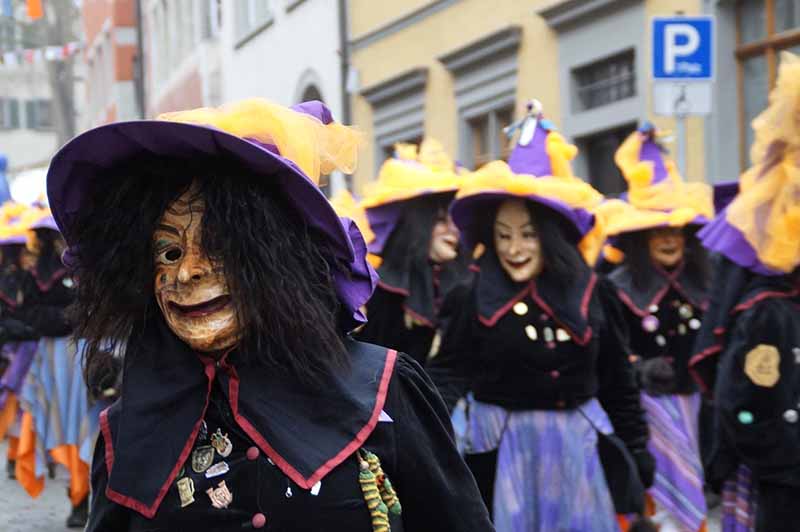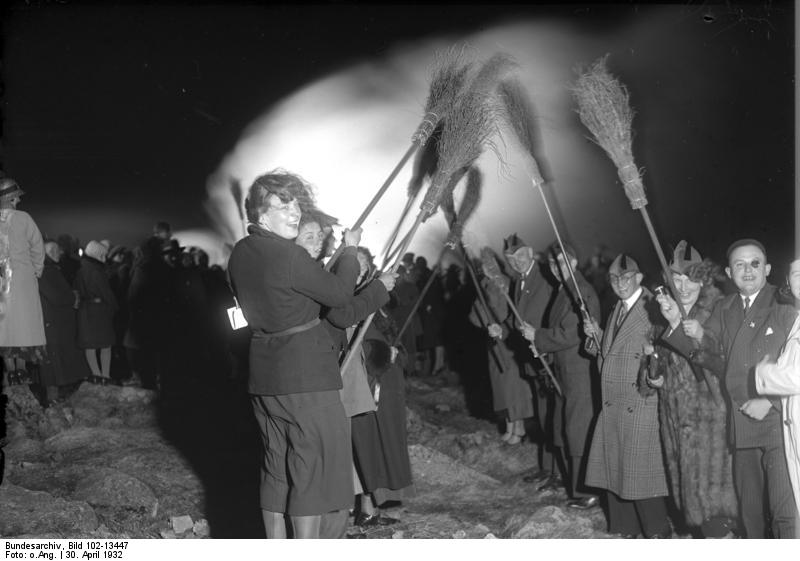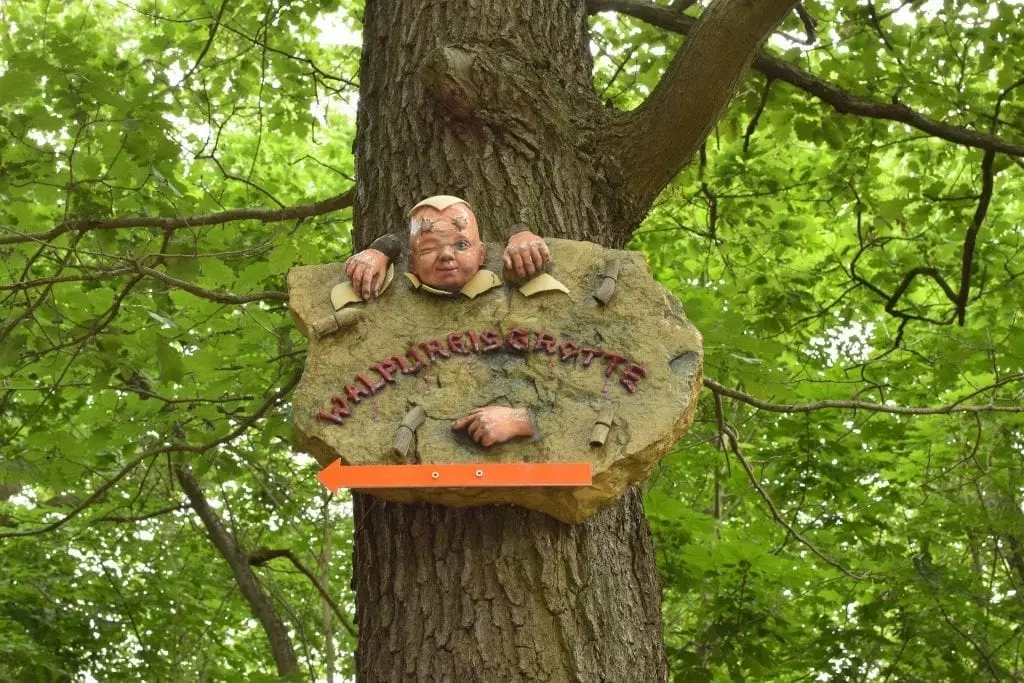Many legends and traditions in Germany feature Witches.. think about all the Fairy Tales you heard as a child cautioning you about witches. Witches in Germany date back to the pagan times, before Christianity, and some of the celebrations or customs still show up in the modern world. Interestingly, Walpurgisnacht or Hexennacht (Witches’ Night), Halloween’s calander opposite, is what happens when Christianity and Pagan traditions mix. (Why else would it be named for a Christian Saint?). What is Walpurgisnacht (pronounced Val-purr-gess-nach-t), and how do people celebrate? With a bonfire! But for the whole story, you need to start at the beginning…
What is Walpurgisnacht?
The Beginnings…
Early in Germany’s history, people celebrated the coming of Spring. The end of a long winter meant the end of hunger and a chance for new life. According to tradition to help usher in the new season, all the Witches and Warlocks would fly in from all around Germany on Broomsticks or goats, and come together on the Brocken on April 30th. This highest peak of the Harz Mountains was the meeting place for Walpurgisnacht, to celebrate and await the arrival of Spring with bonfires and dancing.
Blocksberg (in the Harz) has been associated with witches since the third century (although it’s more likely that these were just ordinary pagans looking for a place to celebrate in privacy). Charlemagne declared all witchcraft and even witchy behavior punishable by death, and the witch trials of 1484 intensified the fears. The Blocksberg area is quite high up, and often shrouded in cloud cover, the woods surrounding the mountain are denser than the Black Forest. All of this makes it a good place to be away from the prying eyes of the church officials who would put pagans to death for following the old rituals.

What began as a celebration of Spring, morphed into something different. The rituals that once greeted the season, would now be used to chase away evil spirits.
In villages and towns, people decided that noise would scare the witches away, so beginning at Sunset, men and boys would do all they could to make noise all night long… banging pots and shooting pistols into the air. Chanting and the banging of boards against the house wall was also thought to chase spirits. Bonfires were lit to keep witches away… this could be the origin of the Easter Fires.
Walpurgisnacht is Quite Common in German Literature
Walpurgisnacht stories are quite common in German literature. You find mention by Jacob Grimm in his Deutsche Mythologie, in a chapter of Goethe’s Faust, Thomas Mann’s “The Magic Mountain” has a chapter titled Walpurgisnacht, and even Bram Stokers short story “Dracula’s Guest” talks about this magical night.

– Jacob Grimm.
Mendelsohn, a friend of Goethe, spent 13 years putting Goethe’s poem “Die erste Walpurgisnacht” (“The First Walpurgisnacht) to music.
Mendelssohn: Die erste Walpurgisnacht
And there was this story from August Ey’s Harzmerchenbuch, published in 1862.
(Story copied from the Free Library article- Season of the Witch- Ridden by a Witch)
“A Harz miner pours scorn on claims that witches ride to Brocken Mountain on Walpurgisnacht. “Nonsense,” he says. “If ever I see such a creature, I’ll wrestle her to the ground. No old hag stands a chance against the likes of me.”
“Be careful what you say,” warns his elderly female neighbor. “Such riders wouldn’t be easy to overcome.”
The next Walpurgisnacht, everybody is shooting off pistols to prevent witches and evil spirits from approaching the village. “More nonsense,” scoffs the man, en route to report for the night shift at the mine. On his way, he encounters a troop of witches swarming through the air.
To his horror, one hag casts aside her broomstick and leaps on his back. Unable to shake her off, he finds himself being ridden like a winged horse toward the Brocken. Rather than being a lightweight bundle of skin and bone, the crone upon his back is incredibly heavy. He feels sure his own bones are about to snap like twigs.
When the witch finally dismounts, the miner collapses on the ground, totally spent. The rest of the coven then surrounds him, dancing with the devil. Eventually they give him the choice of either never telling anybody about his experience or being boiled in oil. Quite understandably, the miner promises to keep silent. “Beware,” spits the devil. “If you utter a single word to any person about our revels, death will come to claim you.” (The story draws a veil on the rest of the scene, merely stating that the witches did “unspeakable” things on the Brocken’s summit.)
As midnight draws near, the witches prepare to depart. One remounts the miner, and they all fly off into the air, only stopping to leave him where they found him. He staggers home to find his wife already dressed, ready to go into the forest to collect firewood. He begs her not to go out just yet. He’s had a rotten night at work and needs to change his clothes. Thinking his wife has gone into the next room, he pours out his incredible tale to the kitchen stove. She, however, overhears every word but says nothing.
Later that day, the elderly neighbor stops by. “A good thing you spoke to the stove and not a person,” she says. “Otherwise things would go ill with you.”
The miner suddenly realizes she is one of the Brocken witches. As he must keep silent, his wife reports the neighbor and she is burned to death. “Just as she deserved,” the story gleefully concludes”

Why April 30?
Then Pagan Custom and Church Custom get tangled up. In the Middle Ages the end of April signaled the end of Winter, and the beginnings of Spring (it’s exactly 6 months from All Saints Day or Samhaim). People celebrated the arrival of warmer weather, and the lengthening of days with bonfires and dancing. It’s possible that like Ostara (the pagan goddess who Grimm says gives us the name for Easter), there WAS once a goddess or divinity of springtime and fertility named Walburga or Waldborg. It is said that Walburga made grain grow when she passed through the fields. When the Church began to impose its power, people chose not to entirely do away with old pagan custom, instead, they wrapped it up into church custom, and celebrate Walpugisnacht (Walpurgis Night). Instead of a 9 day fertility festival, now people to honored the feast day of St Walpurga. And this is where the nun comes in….
Who was St Walpurga?

St Walpurga was born in Devonshire, England in 770AD. As a young woman she traveled ] to Mainz, Germany to perform missionary work under her uncle St Boniface. After leaving Mainz, she went to Heidenheim, Germany, where she took the job of abbess at the local convent. Coincidentally(?) her brother headed the neighboring Monastery (seems that Sainthood runs in some families). After his death, she took over his position. In her time she oversaw the baptizing of many pagans in the local Heidenheim Brunnen.
After her death, the walls of her tomb began oozing a healing oil. Because of this miracle, the church canonized Walpurga, and subsequently chopped up and dispersed the across Germany and France to spread the miracle to everyone. (Seems like Her feast day, is May 1, and she is considered the Patron Saint of Coughs, Storms, Hydrophobia and Sailors.
This is where things start getting a little intertwined….
The symbols associated with St Walpurga are the Spindle, Grain and a Dog (that’s where the hydrophobia ie. Rabies comes in). And you will see Spindles and sheaves of grain carved into monuments or shrines devoted to her. These symbols also overlap Pagan symbols; grain for good harvest, dogs (not cats) are considered the “familiars” for German Goddesses… and of course, the Spindle is associated with Frau Holda (or Holga) of Grimm’s Fairy Tale fame.
So… people could tell the Church Officials they celebrated St Walpurga, when the symbols and celebrations were actually the same as the old Pagan Goddess symbols. (While crossing their fingers behind their back for the small fib) And no one would get into trouble.
Essentially, St Walpurga was an English woman who went to Germany to work for the Catholic Church, but ended up associated with Holga, a Germanic goddess, and later with pagan witches.

Walpurgisnacht Customs
Winters in Germany were long and hard for peasants who farmed. It is no wonder that people celebrated the coming of Spring, and surrounded it with magical rituals. Like May Day celebrations, dancing and jumping around, especially around fire is at the center of Walpurgis Night tradition.
Grain would grow as high as a farmer could jump on Walpurgis Night… and to avoid bad weather and ensure good crops, farmers might put out bread with honey and butter in the fields. Extra care was taken to protect cattle from harm. Bells were blessed and hung from cow’s necks. Stable doors were locked and hung with three crosses.
The lady of the house would customarily leap over her broom…. and old brooms would be burned.
Walpurgisnacht fires were also used to burn anything that had worn out over the previous year, and straw men were made and endowed with things like illness and disease, even bad luck and burned in the fires as well.
Ironically, in another twist of Pagan custom… children would gather greenery from Juniper, Hawthorn, Ash and Elder trees, and hang it around the house and barn. Once upon a time these were considered offerings to the goddess, now they were used to frighten witches and other evil spirits.

A single woman could place a linen thread near a statue of the Virgin Mary, then at midnight onWalpurgis Night, she would unravel it and recite the poem:
“Thread, I pull thee;
Walpurga, I pray thee,
That thou show to me
What my husband’s like to be.”
The Morning dew on May 1st makes girls who wash in it beautiful.
“The fair maid who on the first of May
Goes to the fields at break of day
And washes in dew from the hawthorn tree
Will ever after handsome be.”
Today Walpurgis Night Traditions Have Changed Again

Massive Walpurgis Night Gathering…
People don’t seem to fear witches anymore, in fact, it seems to be the opposite. Walpurgisnacht has become a sort of Halloween party in Germany today. Kindergarteners dress up and collect candies Up in the Harz Mountains, bonfires are lit, and thousands of people dressed in Witch, Warlock, or Devil costumes come from all over to dance and celebrate on a plateau called the Hexentanzplatz near the town of Thale. And there are many other celebrations all over Saxony-Anhalt.
In parts of Southern Germany, Walpurgisnacht is a night of pranks… a bit like the old Trick part of Halloween’s “Trick or Treat”. Don’t be surprised to find your trashcans overturned in the morning, or a few plants missing from your garden. (And hide your garden gnomes!).
Since May 1 is also Labor Day, Worker’s Marches are quite common in Berlin and some other cities.

Learn more about how YOU can Celebrate Walpurgisnacht
Because in modern times, witches and others may gather openly, Linda Raedisch has written a book of traditions and activities for those who want to celebrate Walpurgisnacht. It contains some craft ideas… and recipes to make your evening special.
Night of the Witches: Folklore, Traditions & Recipes for Celebrating Walpurgis Night
Sign HERZ «HEXLICH WILLKOMMEN» Slate board «flying HEXE» with personal wishful engraving
Slate board «flying HEXE» with personal wishful engraving
Kitchen Witches Bring Good Luck
Insure good results from your cooking… no more burnt food, no more stolen cookies…. Let one of these Kitchen Witches watch over your Kitchen!
(Learn more about Kitchen Witches Here–>Kitchen Witch)
References
Season of the Witch- Ridden By a Witch








Excellent article – and entirely eye-opening to me, since my ancestors came from the Roman Catholic regions of Germany, the Rhineland and Bayern (more than a century ago). I rather understand a bit of this, having read the rather new cult-classic book, “The Hangman’s Daughter.” Which has been translated into hard copies in German and in English – whereon – a suspected “witch” was on trial for practicing herbal medicine – around 1400 – or so. Thanks for putting up this post: Very Interesting
http://chicagoschlager.blogspot.com/
Really interesting element on cultural history of Germany. Thanks for the education
You are quite welcome!
Fantastic read. Thanks for it. 🙂
Saw a movie last night that reminded me of Walpurgisnacht….had to check it out! Very informative. Thank you.
What movie was it?
Have a Wicked Walpurgis 2020 !
Great to be reminded of these customs. I remember the small witch puppets from thread they sold as souvenirs in Thale when I was small. And nice to see you also think that witches or pagans were people who simply followed their ancient rituals, like druids and healers and wise people with important knowledge! Just had to smile when reading about noise, as forest raves are also still popular in Central Europe 🙂
Spent a lovely vacation in Goslar years ago. Really love the Harz. There is a sense of magic there.
I have 2 kitchen witches one I gave my mom years ag
\
Thanks for giving Night of the Witches a mention! I’ve been following your blog for a few years now so i’m super flattered!
The book has a prime spot on my bookshelves! I also love your Old Magic of Christmas. Thank you!!